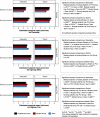Effects of a single interprofessional simulation session on medical and nursing students' attitudes toward interprofessional learning and professional identity: a questionnaire study
- PMID: 32131805
- PMCID: PMC7057493
- DOI: 10.1186/s12909-020-1971-6
Effects of a single interprofessional simulation session on medical and nursing students' attitudes toward interprofessional learning and professional identity: a questionnaire study
Abstract
Background: Participation in simulation-based interprofessional education (sim-IPE) may affect students' attitudes towards interprofessional learning (through gaining experience with others) and their professional identity (by increasing the 'fit' of group membership). We examined this in two questionnaire studies involving students from four universities in two areas of the UK.
Method: Questionnaire data were collected before and after students took part in a sim-IPE session consisting of three acute scenarios. Questionnaires included the Readiness for Interprofessional Learning Scale (RIPLS) and measures of professional identity derived from the social identity theory literature. In Study 1, only identification with Professional Group (doctor or nurse) was measured, while in Study 2 identification with Student Group (medical or nursing student) and the immediate interprofessional Team worked with in the simulation were also measured. Linear mixed effects regression analysis examined the effect of the simulation session, and differences between medical and nursing students, sites and identity measures.
Results: A total of 194 medical and 266 nursing students completed questionnaires. A five-item subset of RIPLS (RIPLSCore) was used in analysis. In both studies RIPLSCore increased for all groups following participation in sim-IPE, although this was larger for nursing students in Study 1. Nursing students had consistently higher RIPLSCore scores than medical students at one site. Effects of the session on identity varied between sites, and dimensions of identity. Notably, while positive emotions associated with group membership (Ingroup Affect) increased for Student Group, Professional Group and Team, the sense of belonging (Ingroup Ties) and importance (Centrality) of the group increased only for Team. Nursing students had consistently higher identification scores than medical students.
Conclusions: Participation in a sim-IPE session can improve attitudes towards interprofessional learning. It can also enhance professional identity, particularly as related to emotional aspects of group membership, with possible benefits for wellbeing. Changes in identification with the immediate Team suggest positive psychological consequences of ad hoc Team formation in the workplace. Differences between medical and nursing students suggest their differing opportunities to work with other professions during training may change baseline attitudes and identity. However, a single sim-IPE session can still have an additive effect.
Keywords: Interprofessional learning; Interprofessional simulation; Medical students; Nursing students; Professional identity; RIPLS; Simulation; Social identity theory.
Conflict of interest statement
Author Bryan Burford is an Associate Editor of this journal.
Figures
References
-
- Lopreiato JO, editor. Healthcare simulation dictionary. Washington, DC: Society for Simulation in Healthcare; 2016.
-
- Zhang C, Thompson S, Miller C. A review of simulation-based interprofessional education. Clin Simul Nurs. 2011;7:e117–e126. doi: 10.1016/j.ecns.2010.02.008. - DOI
MeSH terms
LinkOut - more resources
Full Text Sources



